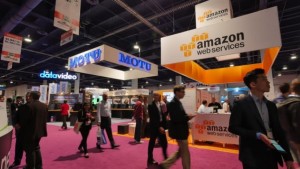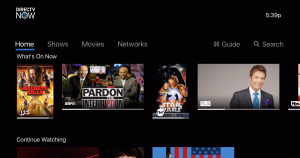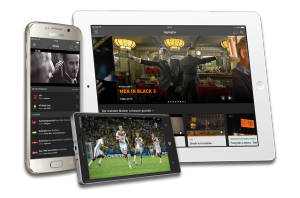Prizefighter – August 2023
My 2022
NAB 2017: How Digital TV Hobbyists Go Pro
This article was originally published in AdExchanger.
 As someone who works in online video, the National Association of Broadcasters (NAB) convention – which starts Saturday – always felt like the show of the titans.
As someone who works in online video, the National Association of Broadcasters (NAB) convention – which starts Saturday – always felt like the show of the titans.
When digital video companies started to emerge at the conference about 10 to 15 years ago as the “disruptors,” they were no more than the industry’s “hobby,” to borrow the phrase Steve Jobs used to describe what Apple TV is for Apple.
But any hobbyist getting enough eyeballs, funding and buzz will eventually go pro. The titans of TV distribution are much bigger and they are destined to rule the world, at least in my opinion, for many years to come.
However, the landscape is changing constantly as digital delivery takes center stage.
The Hype: Big Data And Artificial Intelligence
At some point in the future, most TV will be IP-based. This will pave the way for the next milestone: TV advertising will be completely addressable, allowing marketers to do the type of targeted advertising available on web and mobile, at scale. TV is still, and will continue to be, the biggest game in town.
From its early days, TV distinguished itself by relying on data. TV was always about the numbers, and it did an amazing job making TV advertising and ratings seem like a form of science. It was a great story to tell at the upfronts. However, TV analytics are far from perfect. The actual numbers and the insights provided were and remain somewhat vague.
Then came digital advertising. With all its challenges, this is how our ads are going to be sold and tracked in the future. There are still challenges, but it has the potential to offer much better tools down the road. The TV industry gets it, so much of NAB 2017 will focus on big data, actionable analytics and some form of artificial intelligence.
We see signs of that in the market. When it comes to advertising, Roku is now offering “demographic guarantees” based on its own measurement and Nielsen Digital Ad Ratings. Dish is also getting better at targeted advertising with its Sling TV offering, using Adobe’s Media Optimizer.
It is also interesting to see companies that traditionally offered mostly secured video players now turn to analytics for their future growth. Verimatrix did that about two years ago, and Viaccess-Orca is also moving in the same direction. The key question is how to make these insights actionable. For example, Nice People at Work, which historically tracked quality of service for OTT providers, now wants to use the same technology to predict which viewers are not happy with their OTT service and may be a churn risk.
Finally, Nielsen now claims it can take all of its big data and offer marketers automated campaign optimization based on patent-pending artificial intelligence. Monitoring an ad campaign is notoriously hard for both publishers and marketers, so the ability to let machines do it for them sounds almost too good to be true, but this is the future of TV advertising.
The Face-Off: Amazon, Google And Facebook
Amazon has always had a strong presence at NAB with Amazon Web Services, Amazon Fire and Elemental. As another sign of TV and tech convergence, Google and Facebook will also have a big presence on the show floor this year, with all of them at the entrance of the South Upper Hall.
Facebook’s entire presence will focus on Facebook Live, featuring live technology vendors in a single pavilion. Google, being Google, will likely focus on multiple sides of its TV business: the Android TV platform, DFP’s server-side insertion, which is key for OTT advertising, and maybe even YouTube’s skinny bundle that launched earlier this year.
This is just the tip of the iceberg of what will be showcased this year. If we keep in mind the big-picture trends, we will be able to see the path where it is all headed.
2017 will bring Addressable TV, Mixed Reality, Social vs Publisher Battles, Skinny Bundles and OTT Price Wars
This article was originally published in Videonet.
Those of us who track the digital video industry closely (or any industry for that matter), know the feeling of going through endless news pieces and reports, trying to find a pattern that will reveal where the industry is headed. The truth is that this is hard to do on a daily basis. There’s simply too much information. However, the end of the year is a great time to take a pause, review the main news that came out this year and try to conclude which trends will gain more momentum in 2017. Here are my top five predictions.
The Year of Skinny Bundles
 2017 is going to be crucial for taking the core TV experience over the top. In previous years we saw more content become available online, mostly in the US and the UK, as part of standalone apps (HBO, CBS, Showtime in the US and DisneyLife in the UK), but the TV experience as a whole (think zapping between hundreds of live channels with one DVR to record them all) remained very much behind the traditional walls of cable and satellite TV.
2017 is going to be crucial for taking the core TV experience over the top. In previous years we saw more content become available online, mostly in the US and the UK, as part of standalone apps (HBO, CBS, Showtime in the US and DisneyLife in the UK), but the TV experience as a whole (think zapping between hundreds of live channels with one DVR to record them all) remained very much behind the traditional walls of cable and satellite TV.
This is changing.
SlingTV in the US and Sky Now in the UK had been the industry outliers but they were recently joined by services from Sony, DirecTV and soon Hulu. Even Comcast, the Goliath of cable TV in the US, is toying with the idea and perhaps even Amazon in some capacity.
What is the basic premise of a skinny bundle? 50-150 live channels for about half of the price of cable, running on top of consumer set-top boxes such as Roku and AppleTV. Subscribing and terminating the service is easy. And the experience is pretty close to TV (if you can live with the occasional buffering). In 2017 we will see this experience getting even better with the addition of Cloud DVR to some of these services – and probably a healthy price war that will make this even more appealing to consumers.
Addressable TV is Here
There are two undeniable (and somewhat conflicting) truths about TV advertising: a) it’s flawed, and b) it delivers results and scale like no other medium. But TV advertising is about to get much better. How do I know? Because over the last year I found myself clicking on at least five “suggested posts” in my feed. Two to three times I even bought something. I can’t recall ever doing that before. So what’s the connection between TV advertising and how display ads are becoming better targeted? Addressable TV.
The notion of being able to serve personalised ads in TV pods has existed for a long time, but the infrastructure was never there. Broadcast TV was always too, well… “broad” to be able to serve each household specific ads based on the online behaviour and consumption patterns of the family. However, as more TV services become IP-based, we can a see path to improve TV advertising.
To date, addressable TV was only present in about 3% of the US market, but next year AT&T is planning to sell targeted ads via Direct TV Now. In addition, Facebook’s Audience Network is testing ad delivery in TV apps running on Roku and AppleTV. If Facebook can do as good of a job on the big screen as it does on mobile and web it will have a bright 2017.
OTT Price War
 In 2016 Netflix was finally challenged by other OTT providers, mainly Amazon, who rolled out its video service in 200 countries. Netflix is well positioned to continue to dominate based on its powerful brand and wildly successful original programming strategy (Netflix got the third most Emmy nominees this year; last year it was only placed sixth).
In 2016 Netflix was finally challenged by other OTT providers, mainly Amazon, who rolled out its video service in 200 countries. Netflix is well positioned to continue to dominate based on its powerful brand and wildly successful original programming strategy (Netflix got the third most Emmy nominees this year; last year it was only placed sixth).
But Amazon is making Netflix sweat a little. First, it rolled out a download feature way before Netflix. And it also started acquiring and producing great content. The next stage in this war is a game that Amazon plays better than almost any company in the world – undercutting the competition. Amazon’s Prime Video launched globally this year, offering the service for $2.99. After an introductory period the price goes up to $5.99, still well below Netflix $9.99 HD plan.
Another indication that prices may be shifting came lately from HBO. At $15/month HBO Now is still the most expensive OTT service, but in some skinny bundles it is now offered for $5. Given that the service adoption has been relatively slow (estimated around 1M in the US), Time Warner and its likely new owner, AT&T, may be willing to give away their premium content for a little less. What will Netflix do then?
The Battle of Social versus Publishers
All social networks and apps are putting extra focus on video. And it shows. In 2016, Facebook launched the highly talked-about Facebook Live feature and as a result it has seen 88% growth in video posts. Twitter streamed NFL games with viewership of about 500K at any given moment and Snapchat is making moves to add more video via its Discovery feature.
With these latest moves, media companies are worried about social apps evolving and becoming competitors for eyeballs rather than another distribution platform to drive viewership and ad revenue for them. In that respect, it is interesting to see how cautious YouTube has been about making a push for original content. YouTube’s strategy is now focused on building the most innovative tools (they recently launched 4K live streaming for 2D and 360 video) for brands and media companies so they continue to upload more content to YouTube. Since Facebook and Snapchat need to grow their revenue much faster than YouTube, they may not be as restrained.
VR Will Grow, MR Will Go Mainstream
 The next iPhone launch will be even more festive than usual as Apple marks the 10th anniversary of the device that has changed the world and made Apple the most valuable company on the planet. The iPhone 8 will need to deliver something really spectacular and that thing may be a new Mixed Reality and Virtual Reality technology.
The next iPhone launch will be even more festive than usual as Apple marks the 10th anniversary of the device that has changed the world and made Apple the most valuable company on the planet. The iPhone 8 will need to deliver something really spectacular and that thing may be a new Mixed Reality and Virtual Reality technology.
According to some industry experts, like Robert Scoble, Apple will also launch a new Apple TV and iPad that will change how we use video and interact with the world. In addition, 2017 may be the year in which we finally get to judge for ourselves if the mixed reality headset that Magic Leap has been working on is as great as all the initial reviews by the tech geeks who have had a sneak peak. Those technologies, along with Google’s DayDream and Samsung’s GearVR, will make video in VR even more exciting and valuable in ways that we are only now starting to realise.
How to Develop a TV App for 10 Devices
This article was originally published in Rapid TV News.
 Developing an incredible OTT TV app that meets your business needs and also creates a real buzz with consumers can prove tricky. Doing this across 10 plus platforms (like AppleTV, Amazon Fire, Roku, connected TVs etc.) sounds impossible. But it can actually be done, if planned and executed correctly. Here are some of the lessons we learned when doing this.
Developing an incredible OTT TV app that meets your business needs and also creates a real buzz with consumers can prove tricky. Doing this across 10 plus platforms (like AppleTV, Amazon Fire, Roku, connected TVs etc.) sounds impossible. But it can actually be done, if planned and executed correctly. Here are some of the lessons we learned when doing this.
Planning
Building apps for such a fragmented market requires vision, a well thought-out development plan, and relatively deep pockets. But get the app development right and, provided you have great content too, the positive results will speak for themselves.
Creating TV apps is really expensive so combining multiple business models – transactions, subscriptions, advertising, and freemium – to provide flexibility and maximize revenues is critical. Plus adding dynamic ad insertion, VOD and cloud DVR functionality can further increase revenue potential. Much like in the print magazine world, where consumers used to subscribe to more than one magazine to reflect their multiple interests and hobbies, most people will eventually subscribe to more than one OTT service too. But for this to happen subscription prices need to be squeezed.
In this scenario, having a TV app that supports multiple business models – and makes upselling and cross-selling as friction-free as possible – is the only way to realize revenues and profits.
All of this requires a very strong backend system that offers all of the API calls needed to manage the various business rules. In addition, the same platform must be very smart so it is able to distinguish between devices. With the massive fragmentation in the market, different devices require different technologies to perform the same task. For example, the backend will need to support at least three different DRM standards to deliver encrypted content to all devices; the same backend will likely need to support two or three streaming technologies; and the same complexity exists for tracking analytics and running ads. Therefore, you will need a backend that is like a toolbox and can use different technologies in different scenarios.
Writing Code
In such a fragmented market it would be great to reap efficiencies by using the same code with minor variations. Unfortunately, from a technical point of view, this is not easy. Most of the development for smart TVs, Playstation, Wii U, and Amazon Fire is done with a combination of JavaScript, HTML, and CSS. Replacing the HTML and CSS with custom UI or libraries opens up Apple TV and Xbox One. And Xbox 360 requires C# and XAML. But other platforms use proprietary languages: Roku uses BrightScript, Android native is required for Android TV, phones, and tablets, and of course iOS devices require iOS native. So what’s the best approach?
The smartest thing to do is to use what works in the largest number of environments. Start with web development and build outwards from there. Each TV platform has its own design guidelines. Take the guidelines and focus on creating one great design that works across the overlapping 80%. Invest the time you have saved by creating only one design into making that one design fabulous. And don’t be afraid to divert from the design guidelines a little to make your design stand out from the rest.
The approach above is great for connected TVs, Android STBs and Amazon Fire device. For iOS and Roku, you can develop quickly by relying on their templates. Once you have launched on all devices, you can go back and build customized apps for iOS and Roku which will match the look and feel of your web-based apps.
Launching
There are two ways to launch.
Approach one: launch wide but lean. Develop lightly for as many platforms as possible as quickly as possible. The key is to learn quickly—from your growing experience with the platforms, from usage analytics, and from user responses. Then iterate just as quickly. Invest heavily where initial results show promise and reinforce there. As you gather data, you base later-stage strategy on results. Don’t spend too much money in places where it might not be spent effectively.
Approach two: do a Netflix and go all out to cover all platforms from day one. The fact that this is still a relatively immature market means that there’s still market share up for grabs. If you can move faster and stronger than the competition, you can own it. The downside is that this requires immense resources up front, to create tailored apps as well as compelling content. It’s a bigger gamble, but with a commensurately larger potential reward.
Summary
Creating a true cross-device experience is hard unless, of course, you have an army of developers at your disposal. But as platforms like AppleTV, Roku, Amazon and connected TVs become more developer friendly, smaller teams can build such experiences. Since the fragmentation in the video space is here to stay, this endeavor is worth the effort.
